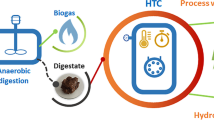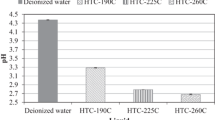Abstract
Interest in hydrothermal carbonization (HTC) is increasing worldwide due to its outstanding capabilities. This study introduces a novel semi-continuous feeding system to feed the biomass slurry against the high pressure of an HTC reactor. As expected in a semi-continuous operation, the biomass would be instantaneously exposed to the desired pressure and temperature, instead of a gradual increase to the desired temperature. Higher degrees of carbonization, lower cellulose crystallinity, improved hexagonal graphene sheets, surface hydrophobic characteristics, and higher thermal stability were observed at elevated temperatures in products from semi-continuous HTC when compared with products from batch operation. Reaction pathways were proposed for both batch and semi-continuous operations on the basis of physical and chemical characterization results. For HTC at 260 °C, the proposed semi-continuous system showed approximately 3% higher carbon content in the obtained hydrochar and a 25-min reduction in required time to reach 260 °C. The promising conclusion of these results is that by introducing continuous systems in HTC, not only will the time of the process cycle decrease, it will also achieve higher degrees of carbonization.




Similar content being viewed by others
References
Hoekman SK, Broch A, Robbins C (2011) Hydrothermal carbonization (HTC) of lignocellulosic biomass. Energy Fuel 25:1802–1810. https://doi.org/10.1021/ef101745n
Safari F, Tavasoli A, Ataei A (2017) Gasification of Iranian walnut shell as a bio-renewable resource for hydrogen-rich gas production using supercritical water technology. Int J Ind Chem 8:29–36. https://doi.org/10.1007/s40090-016-0093-9
Safari F, Norouzi O, Tavasoli A (2016) Hydrothermal gasification of Cladophora glomerata macroalgae over its hydrochar as a catalyst for hydrogen-rich gas production. Bioresour Technol 222:232–241. https://doi.org/10.1016/j.biortech.2016.09.082
Lucian M, Fiori L (2017) Hydrothermal carbonization of waste biomass: process design, modeling, energy efficiency and cost analysis. Energies 10. https://doi.org/10.3390/en10020211
Lynam JG, Reza MT, Yan W, Vásquez VR, Coronella CJ (2015) Hydrothermal carbonization of various lignocellulosic biomass. Biomass Conv Bioref 5:173–181. https://doi.org/10.1007/s13399-014-0137-3
Heidari M, Dutta A, Acharya B, Mahmud S (2019) A review of the current knowledge and challenges of hydrothermal carbonization for biomass conversion. J Energy Inst 92:1779–1799. https://doi.org/10.1016/j.joei.2018.12.003
Dai J, Cui H, Grace JR (2012) Biomass feeding for thermochemical reactors. Prog Energy Combust Sci 38:716–736. https://doi.org/10.1016/j.pecs.2012.04.002
Hoekman SK, Broch A, Felix L, Farthing W (2017) Hydrothermal carbonization (HTC) of loblolly pine using a continuous, reactive twin-screw extruder. Energy Convers Manag 134:247–259. https://doi.org/10.1016/j.enconman.2016.12.035
Hoekman SK, Broch A, Robbins C, Purcell R, Zielinska B, Felix L et al (2014) Process development unit (PDU) for hydrothermal carbonization (HTC) of lignocellulosic biomass. Waste Biomass Valorization 5:669–678. https://doi.org/10.1007/s12649-013-9277-0
Stemann J, Ziegler F (2011) Assessment of the energetic efficiency of a continuously operating plant for hydrothermal carbonisation of biomass. World Renew Energy Congr 2011 - Sweden:125–32. https://doi.org/10.3384/ecp11057125.
Ching D (2014) Upgrading of biomass : alternative ways for biomass treatment, Thesis for Master of Science Degree. KTH School of Industrial Engineering and Management.
Gómez J, Corsi G, Pino-Cortés E, Díaz-Robles LA, Campos V, Cubillos F et al (2019) Modeling and simulation of a continuous biomass hydrothermal carbonization process. Chem Eng Commun 0:1–18. https://doi.org/10.1080/00986445.2019.1621858
Pütün AE, Özbay N, Apaydın Varol E, Uzun BB, Ateş F (2007) Rapid and slow pyrolysis of pistachio shell : effect of pyrolysis conditions on the product yields and characterization of the liquid product. Int J Energy Res 31:506–514. https://doi.org/10.1002/er.1263
Lim JY, Chatzakis IN, Megaritis A, Cai HY, Dugwell DR, Kandiyoti R (1997) Gasification and char combustion reactivities of Daw Mill coal in wire-mesh and “hot-rod” reactors. Fuel 76:1327–1335. https://doi.org/10.1016/S0016-2361(97)00029-X
ASTM D7582-10 (2012) Standard test methods for proximate analysis of coal and coke by macro thermogravimetric analysis. vol. i. . https://doi.org/10.1520/D7582.
Heidari M, Salaudeen S, Dutta A, Acharya B (2018) Effects of process water recycling and particle sizes on hydrothermal carbonization of biomass. Energy Fuel 32:11576–11586. https://doi.org/10.1021/acs.energyfuels.8b02684
Wang Y, Qiu L, Zhu M, Sun G, Zhang T, Kang K (2019) Comparative evaluation of hydrothermal carbonization and low temperature pyrolysis of Eucommia ulmoides Oliver for the production of solid biofuel. Sci Rep:1–11. https://doi.org/10.1038/s41598-019-38849-4
Heidari M, Norouzi O, Salaudeen S, Acharya B, Dutta A (2019) Prediction of hydrothermal carbonization with respect to the biomass components and severity factor. Energy Fuel 33:9916–9924. https://doi.org/10.1021/acs.energyfuels.9b02291
Kruse A, Funke A, Titirici MM (2013) Hydrothermal conversion of biomass to fuels and energetic materials. Curr Opin Chem Biol 17:515–521. https://doi.org/10.1016/j.cbpa.2013.05.004
Lucian M, Volpe M, Gao L, Piro G, Goldfarb JL, Fiori L (2018) Impact of hydrothermal carbonization conditions on the formation of hydrochars and secondary chars from the organic fraction of municipal solid waste. Fuel 233:257–268. https://doi.org/10.1016/j.fuel.2018.06.060
Volpe M, Goldfarb JL, Fiori L (2018) Hydrothermal carbonization of Opuntia ficus-indica cladodes: role of process parameters on hydrochar properties. Bioresour Technol 247:310–318. https://doi.org/10.1016/j.biortech.2017.09.072
Mäkelä M, Volpe M, Volpe R, Fiori L, Dahl O (2018) Spatially resolved spectral determination of polysaccharides in hydrothermally carbonized biomass. Green Chem 20:1114–1120. https://doi.org/10.1039/c7gc03676k
Becker R, Dorgerloh U, Paulke E, Mumme J, Nehls I (2014) Hydrothermal carbonization of biomass: major organic components of the aqueous phase. Chem Eng Technol 37:511–518. https://doi.org/10.1002/ceat.201300401
Liu Z, Quek A, Kent Hoekman S, Balasubramanian R (2013) Production of solid biochar fuel from waste biomass by hydrothermal carbonization. Fuel 103:943–949. https://doi.org/10.1016/j.fuel.2012.07.069
Funke A, Ziegler F, Berlin TU (2010) Hydrothermal carbonization of biomass : a summary and discussion of chemical mecha- nisms for process engineering. Biofuels Bioprod Biorefin:160–177. https://doi.org/10.1002/bbb
Sabegh MY, Norouzi O, Jafarian S, Khosh AG, Tavasoli A (2018) Pyrolysis of marine biomass to produce bio-oil and its upgrading using a novel multi-metal catalyst prepared from the spent car catalytic converter. Bioresour Technol 249:473–478. https://doi.org/10.1016/j.biortech.2017.10.017
Liu Z, Zhang F, Hoekman SK, Liu T, Gai C, Peng N (2016) Homogeneously dispersed zerovalent iron nanoparticles supported on hydrochar-derived porous carbon: simple, in situ synthesis and use for dechlorination of PCBs. ACS Sustain Chem Eng 4:3261–3267. https://doi.org/10.1021/acssuschemeng.6b00306
Guo S, Dong X, Liu K, Yu H, Zhu C (2015) Chemical, energetic, and structural characteristics of hydrothermal carbonization solid products for lawn grass. BioResources 10:4613–4625. https://doi.org/10.15376/biores.10.3.4613-4625
Zhang B, Heidari M, Regmi B, Salaudeen S, Arku P, Thimmannagari M et al (2018) Hydrothermal carbonization of fruit wastes: a promising technique for generating hydrochar. Energies 11:2022. https://doi.org/10.3390/en11082022
Mumme J, Eckervogt L, Pielert J, Diakité M, Rupp F, Kern J (2011) Hydrothermal carbonization of anaerobically digested maize silage. Bioresour Technol 102:9255–9260. https://doi.org/10.1016/j.biortech.2011.06.099
Zhu X, Liu Y, Qian F, Zhang S, Chen J (2015) Investigation on the physical and chemical properties of hydrochar and its derived pyrolysis char for their potential application : In fluence of hydrothermal carbonization conditions. Energy Fuel 29:5222–5230. https://doi.org/10.1021/acs.energyfuels.5b00512
Chen X, Li H, Sun S, Cao X, Sun R (2016) Effect of hydrothermal pretreatment on the structural changes of alkaline ethanol lignin from wheat straw. Sci Rep:1–9. https://doi.org/10.1038/srep39354
Śliz M, Wilk M (2020) A comprehensive investigation of hydrothermal carbonization: Energy potential of hydrochar derived from Virginia mallow. Renew Energy 156:942–950. https://doi.org/10.1016/j.renene.2020.04.124
Gao L, Volpe M, Lucian M, Fiori L, Goldfarb JL (2019) Does hydrothermal carbonization as a biomass pretreatment reduce fuel segregation of coal-biomass blends during oxidation? Energy Convers Manag 181:93–104. https://doi.org/10.1016/j.enconman.2018.12.009
Heidari M, Salaudeen S, Norouzi O, Acharya B, Dutta A (2020) Numerical comparison of a combined hydrothermal carbonization and anaerobic digestion system with direct combustion of biomass for power production. Processes 8. https://doi.org/10.3390/pr8010043
Elaigwu SE, Greenway GM (2016) Microwave-assisted hydrothermal carbonization of rapeseed husk: a strategy for improving its solid fuel properties. Fuel Process Technol 149:305–312. https://doi.org/10.1016/j.fuproc.2016.04.030
Kruse A, Zevaco T (2018) Properties of hydrochar as function of feedstock, reaction conditions and post-treatment. Energies 11:674. https://doi.org/10.3390/en11030674
Wu J, Collins SRA, Elliston A, Wellner N, Dicks J, Roberts IN, et al (2018) Biotechnology for Biofuels Release of cell wall phenolic esters during hydrothermal pretreatment of rice husk and rice straw. 1–12.
Sevilla M, Maciá-Agulló JA, Fuertes AB (2011) Hydrothermal carbonization of biomass as a route for the sequestration of CO 2: chemical and structural properties of the carbonized products. Biomass Bioenergy 35:3152–3159. https://doi.org/10.1016/j.biombioe.2011.04.032
Zhang S, Su Y, Xu D, Zhu S, Zhang H, Liu X (2018) Assessment of hydrothermal carbonization and coupling washing with torrefaction of bamboo sawdust for biofuels production. Bioresour Technol 258:111–118. https://doi.org/10.1016/j.biortech.2018.02.127
Oktaviananda C, Rahmawati RF, Prasetya A, Purnomo CW, Yuliansyah AT, Cahyono RB (2017) Effect of temperature and biomass-water ratio to yield and product characteristics of hydrothermal treatment of biomass. AIP Conf Proc 1823. https://doi.org/10.1063/1.4978102
Zhang X, Zhang L, Li A (2018) Eucalyptus sawdust derived biochar generated by combining the hydrothermal carbonization and low concentration KOH modification for hexavalent chromium removal. J Environ Manag 206:989–998. https://doi.org/10.1016/j.jenvman.2017.11.079
Acknowledgments
The authors would like to acknowledge the students of the University of Guelph that were involved in the design and fabrication of the semi-continuous system: Jonathan Pile, Brian Seed, Jason Wilson, Rosy Tutton, Diana Constantinescu, Mohammad Shallouf, and Umna Arshad.
Funding
The study was financially supported by the research grants from Natural Sciences and Engineering Research Council of Canada (NSERC Discovery), Ministry of the Environment and Climate Change (MOECC) for Best in Science program, and Ontario Ministry of Agriculture, Food, and Rural Affairs (OMAFRA).
Author information
Authors and Affiliations
Corresponding author
Additional information
Publisher’s note
Springer Nature remains neutral with regard to jurisdictional claims in published maps and institutional affiliations.
Electronic supplementary material
ESM 1
(DOCX 265 kb)
Rights and permissions
About this article
Cite this article
Heidari, M., Norouzi, O., MacDermid-Watts, K. et al. Product evaluation of hydrothermal carbonization of biomass: semi-continuous vs. batch feeding. Biomass Conv. Bioref. 12, 15–25 (2022). https://doi.org/10.1007/s13399-020-00932-6
Received:
Revised:
Accepted:
Published:
Issue Date:
DOI: https://doi.org/10.1007/s13399-020-00932-6




